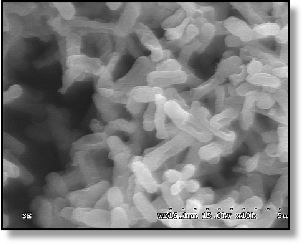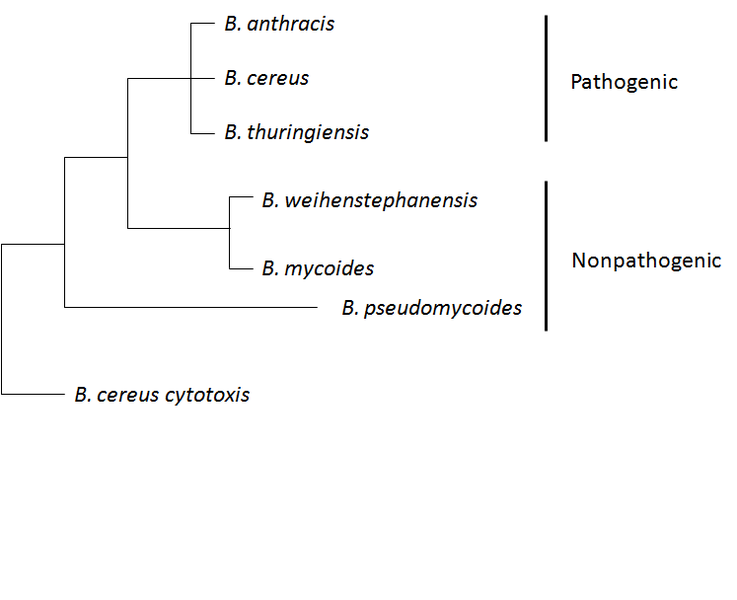Classification
Here I will give you the entire classification of Bacillus cereus, some information on what makes the taxonomic class unique, along with other examples of organisms in the same classification! Some may ask 'What do you mean by classification?' Well, classification is a method of organizing different organisms into different groups based on similar characteristics. Why does this matter? Classification has allowed us to easier study the wide variety of organisms, understand the relationships among different groups, and there are many other ways that classification has helped us! So you have been reading about this organism Bacillus cereus, and you are probably thinking that it is one weird name. Don't worry! There is a meaning behind it! Bacillus means "rod" in Latin, and cereus means "wax". Okay, that may not make complete sense right away. But, if you think of it in terms of the organisms appearance (pictured below) you can see why it received the name it did!
Domain- Bacteria: All of the members possess
peptidoglycan in their cell walls, and are prokaryotic. Peptidoglycan
consists of amino acids and sugars, and helps compose the cell wall. Most
prokaryotes tend to be unicellular, and lack a membrane-bound nucleus, a
mitochondria, and chloroplast. (Nostoc)
Kingdom- Eubacteria: Members of this kingdom are all single celled, and prokaryotic. Eubacteria is the only kingdom of the bacteria domain. (Helicobacter)
Phylum- Firmicutes: Firmicutes are all gram positive, and show a low DNA % G+C. To be gram positive, means that the organism has been tested with a gram stain test, a test which determines whether the organism has peptidoglycan on the outside of their cells walls or on the inside, and appears dark purple under a microscope indicating the presence of peptidoglycan on the outside of the cell walls. (Boltulinum toxin)
Class- Bacilli: The name of this class implies the morphological shape of the organisms; bacilli means to be rod shaped. This is noticeable when looking at Bacillus cereus. (Xanthomonas compestris)
Order- Bacillales: Members of this order possess the capability of forming endospores, which can be read about in greater detail in adaptations. (MRSA)
Family- Bacillacae: All members of bacillacae are Aerobic. This means that they use oxygen in cellular respiration. This characteristic can have a major impact on their habitat, as oxygen availability varies based on the surrounding environment. (Alkalibacillus halophilus)
Genus- Bacillus: Members of the genus bacilicus inhabit soil, can be found in water, and posses peritrichous flagella for movement. More about peritrichous flagella can be read about in adaptations. (Anthrax)
Species- Bacillus cereus: Bacillus cereus is differentiated from its similar relatives Bacillus anthracis and Bacillus thuringiensis based off of phenotype and pathological effects. In terms of pathological effects, Bacillus anthracis is known to cause the fatal disease anthrax, Bacillus thuringiensis is often used as a biological pesticide, and Bacillus cereus is known to cause food poisoning. It can be very difficult to differentiate between the three bacteria.
Above is a cladistic phylogenetic tree of Bacillus cereus. Cladistic phylogenetic trees are based off of
synapomorphies, which are shared derived characteristics from a common
ancestor. As you can see, Bacillus cereus
is very closely related to Bacillus anthracis (as mentioned
earlier, Bacillus anthracis is more commonly known as anthrax) and Bacillus thuringiensis.
All three, as shown by the tree, are pathogenic. All of the members above
belong to the bacillus genus, therefore share the majority of
characteristics provided in the classification above. This is a over simplified cladistic phylogenetic tree, look below for a more complex.
Shown above is a more complex cladistic phylogenetic tree for Bacillus cereus. I have modified it to fit the web page, to view the full tree click on the image. Here you see some more distant relatives. As you can see, this tree has a much broader range of diversity in terms of geneses, it is not only limited to the bacillus genus. All of the above are classified as bacteria.
So where might you ask would this organism be found?
To continue learning, click here to go to habitat!
MultipleOrganisms.net
Home page
Contact me
